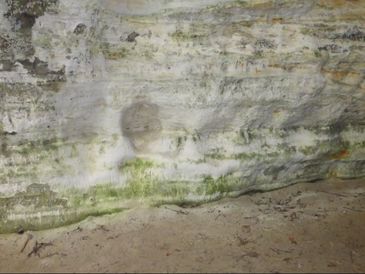In the face of a sandstone cliff is a large alcove – a sort of half-cave. It has a semicircular, level floor of loose sand, widest at the cliff face. The sandstone walls of the rock shelter’s interior rise vertically from the floor, then arch overhead to form a natural amphitheater. This sheltered space sits well above a stream running in the narrow, wooded valley below, at the top of a ramp of sandy soil and loose sandstone blocks.
Dimensions The cliff is 50 feet (15 m) high, and the shelter sits 20 feet (6 m) above the valley floor. The alcove floor is 30 feet (10 m) wide at the cliff front, and extends about 20 feet (6 m) inward. The arched ceiling reaches more than 20 feet (6 m) in height. Smaller rock shelters in other places nearby range from a quarter of this size on up.
Key Details
- The rock walls are moist, with seeping water in some places. On warm days the interior of the rock shelter will feel cool. In winter there may be films of sandy ice on the walls, which can be pulled off by hand.
- The sandstone here is soft – you can carve a message in it with a knife. Some graffiti appearing on the wall is an obvious sign of that.
- A very thin outer surface layer of the rock walls is even softer – in fact, it is slowly disintegrating. Individual grains of sand are slowly coming loose and falling to the ground. If someone leaves an object on the ground in the rock shelter, and comes back in weeks or years, they will find a thin sand coating, or even a thick sand cap, on top of it. The disintegration will erase any message cut into the rock face in a few years, so whatever is found on the wall will be fairly recent.
- This arched space is a natural amphitheater. Words spoken in the front center of the floor, below the lip of the overhanging roof, are amplified back to the speaker and carry clearly to all parts of the room and valley opposite. Sounds made near the back and side walls not carrying so far. In daytime the center place is also more brightly lighted than other parts of the shelter, due to a break in foliage just above.
- The alcove faces east. In the evening it is in deep shadow, but in the morning, when the sun breaks over nearby cliffs, intense sunlight reflects off of the alcove’s floor onto its tan sandstone walls and ceiling, bathing the site in warm light. At night, a campfire on the alcove floor will make the whole space glow.
- Tall deciduous trees grow in the surrounding valley, on the ramp below the shelter, and on the ground above the cliffs. There is little brushy undergrowth on slopes, but bushes are thick near the stream. Small patches of poison ivy are common on the forest floor.
- The ramp slope is fairly steep to climb, with scattered fallen logs providing further obstacles and some additional cover.
Story Elements

- This could be an easily identifiable spot for a rendezvous. For residents of the region, it might be a place culturally set apart: a ceremonial site, a performance venue, a no-weapons spot for truce/parlay.
- The shelter’s rock walls provide key places to leave or look for clues/messages. Its loose sand floor could be used in the same way for more short-term communication.
- The large, level floor and partial shelter from weather makes this a good group campsite, with water available 30 yards away in the small stream running in the valley.
- A talking character strolling toward center of the shelter might be surprised, embarrassed, or encouraged to hear her/his voice suddenly reverberating and amplified.
- The elevated sand platform provides a fairly good vantage point for observing the valley – very good in winter and early spring, when foliage is absent.
- Spies can observe the interior of the rock shelter from many locations/angles, including a vantage point on the valley’s opposite cliff, a branch up in one of the trees, or from directly above, leaning over the edge of the cliff top that thinly roofs the shelter (with aid of an anchor rope or other support).
- Tree trunks on the ramp provide concealment for someone stealing upward toward the rock shelter. Otherwise, a concealed path of approach should closely hug the cliff base just to the left or right of the inset overhang.
- Combat dynamics:
- This might be selected as a more defendable place to stave off an attack, but people with backs to the wall in this shelter also accept the disadvantages of no cover and limited direction of exit.
- Tactics in hand-to-hand fighting might include tumbling moves on the soft floor, throwing sand into eyes, and pushing opponents into the rock walls.
- In winter, icicles that hang from the shelter walls, and ice sheets loosely attached to them, might be broken off for use as ad hoc hand weapons or projectiles. During spring melt, fallen/falling pieces of this ice on the sand floor might complicate a fight.
Reference Location
Council Overhang, in Starved Rock State Park, northern Illinois.
© Rice-Snows 2017
Proudly powered by Weebly








